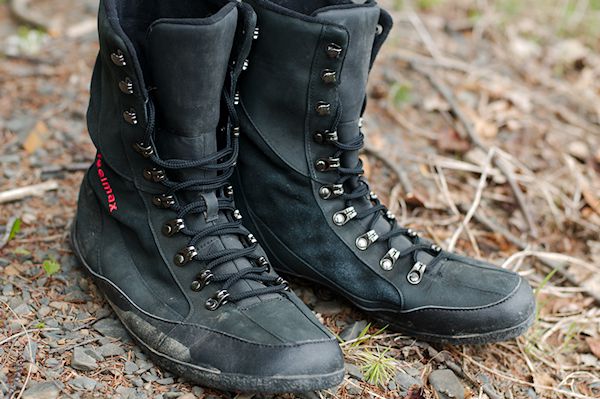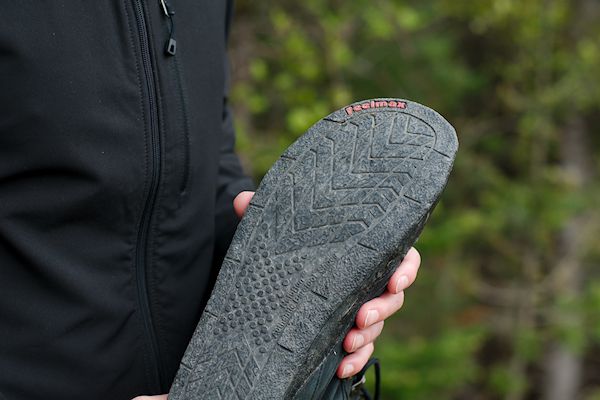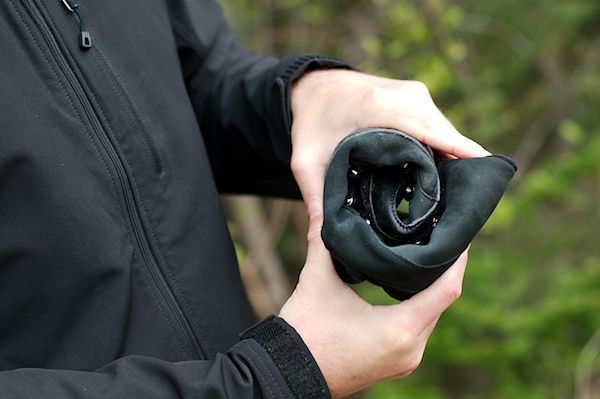Toe Salad has a long history with the Kuuva - actually a long history with Feelmax as a brand. In the very early days of this site (when it was called ADVENTUREinPROGRESS), one of the very first shoe reviews we did was a review of the Feelmax Niesa. Somewhere along the way when I was communicating with Feelmax about the Niesa, they sent me a photo of the Kuuva and I was in absolute shock.
The Kuuva was innovative. It was the first-ever hiking boot, purpose-built for the barefoot/minimalist shoe crowd. I was especially excited because one of the biggest weaknesses of minimalist footwear was (and largely still is) cold. Most of the available options at the time were too cold for below freezing conditions. I was hopeful that the Kuuva would bring some much needed warmth to the world of barefoot shoes.
Version 1 of the Kuuva featured the same sole as the version 1 of the Osma (Feelmax's road running shoe). It's high-top upper was constructed out of an artificial leather product called Clarino, and a canvas-like fabric.
While version 1 of the Kuuva was a good first attempt, it was far from perfect. The Clarino - while quite water resistant - was not very breathable, and a little too stiff. The opening around the ankle was narrow and made it difficult to put the shoes on. Additionally, there were design/fabrication issues with the sole that caused it to come apart pre-maturely (as with the Osma v1).

The Kuuva 2 is designed specifically to address all of those problems. The boot is now built using leather (Waterbuck water-resistant suede) instead of Clarino. This improves breathability and flexibility, and has the side-effect of making them even more aesthetically pleasing. The shoe opening around the ankle has been re-designed to make putting the boots on much easier. The Kuuva 2 also uses version 2 of the Feelmax NatuRun sole - the same sole used on the Osma 2.
Note: this is not the version 3 sole as can be found on the Vasko or the Osma 3 (although based on what I am seeing with the Feelmax line, I am sure it is coming at some point).

What I like about the Kuuva:
- The design is truly mnmlst. The sole is thin and flexible, the boot has the most ground feel of any minimalist boot I have tried. Although they are a high-top boot, the soft leather around the ankle is very flexible and unrestricting. They get softer with age.
- I don't need a gaiter. You might be wondering what the purpose is of a over-the-ankle boot is when the high-top isn't there to provide support: it is there to provide protection from abrasion and act like a built-in gaiter.
- The boot is durable. The quality and workmanship is top-notch. The sole is a definite improvement over the previous version, and so far the durability seems to be much better.
- They look good. Thee Kuuva has always been eye catching, and has only gotten better with version 2.

My biggest issue with the Kuuva is...
- Limited seasonal usefulness. I find them too hot for summer, and too cold for winter. For me, they are best suited for spring and fall.
I have heard that some people can wear them in winter, I have tried, and found the soles to be too thin for the cold. I ordered my pair a size larger so that I could use them with extra-thick socks in winter conditions. I now regret this decision as even with thick wool socks, they didn't keep my feet very warm, and now they are a bit bigger than I would like with regular socks. Oh well.
I have not had the opportunity to use the Kuuva in all conditions, however, based on my observations and experience, I can say this:
- The sole of the Kuuva is flat and flexible. This works great for trails, rocks, and general outdoorsy conditions. A sole like this will have limited grip in steep, loose, and/or muddy conditions.
- The upper is water-resistant leather. This is fine for everyday casual outdoor use and day hiking, but would be problematic for multi-day backpacking trips in potentially wet conditions as they take a long time to dry out. I would never consider wearing the Kuuva for a stream crossing - for those types of conditions, a quick-drying mesh trail runner is a better bet.

As you may know, I am a believer in the shoes are tools mindset, and as they say, you use the right tool for the job. The question I ask whenever evaluate a pair of footwear is... what is the right job for this tool? Or, perhaps what is the job best suited for this tool?
After spending several months with the Feelmax Kuuva, I can say that the best job for this boot is the outdoors in spring and fall. Hiking, hunting, etc. in cold, damp, rugged conditions is their sweet spot. If you are looking for minimalist footwear that suits those conditions, you definitely want to give the Kuuva a closer look.
